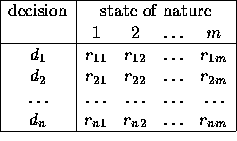
Decision theory treats decisions against nature. This refers to a situation where the result (return) from a decision depends on action of another player (nature). For example, if the decision is to carry an umbrella or not, the return (get wet or not) depends on what action nature takes. It is important to note that, in this model, the returns accrue only to the decision maker. Nature does not care what the outcome is. This condition distinguishes decision theory from game theory. In game theory, both players have an interest in the outcome.
The fundamental piece of data for decision theory problems is a payoff table:

The entries ![]() are the payoffs for each possible combination of
decision and state of nature. The decision process is the following.
are the payoffs for each possible combination of
decision and state of nature. The decision process is the following.
The question faced by the decision maker is: which decision to select?
The decision will depend on the decision maker's belief concerning what
nature will do, that is, which state of nature will occur. If we believe
state j will occur, we select the decision ![]() associated with the largest
number
associated with the largest
number ![]() in column j of the payoff table. Different assumptions
about nature's behavior lead to different procedures for selecting ``the
best'' decision.
in column j of the payoff table. Different assumptions
about nature's behavior lead to different procedures for selecting ``the
best'' decision.
If we know which state of nature will occur, we simply select the decision that yields the largest return for the known state of nature. In practice, there may be infinitely many possible decisions. If these possible decisions are represented by a vector d and the return by the real-valued function r(d), the decision problem can then be formulated as
![]()
The linear programming model studied earlier in this course fits in this category. In this case, r(d) is a linear function and the feasibility constraints are linear as well. Many other deterministic models of operations research also fall in this category.
In the remainder of this chapter, we consider decisions under risk.